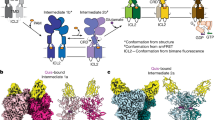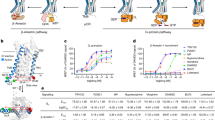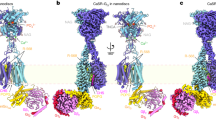Abstract
Heterotrimeric G proteins serve as membrane-associated signaling hubs, in concert with their cognate G-protein-coupled receptors. Fluorine nuclear magnetic resonance spectroscopy was employed to monitor the conformational equilibria of the human stimulatory G-protein α subunit (Gsα) alone, in the intact Gsαβ1γ2 heterotrimer or in complex with membrane-embedded human adenosine A2A receptor (A2AR). The results reveal a concerted equilibrium that is strongly affected by nucleotide and interactions with the βγ subunit, the lipid bilayer and A2AR. The α1 helix of Gsα exhibits significant intermediate timescale dynamics. The α4β6 loop and α5 helix undergo membrane/receptor interactions and order–disorder transitions respectively, associated with G-protein activation. The αN helix adopts a key functional state that serves as an allosteric conduit between the βγ subunit and receptor, while a significant fraction of the ensemble remains tethered to the membrane and receptor upon activation.
This is a preview of subscription content, access via your institution
Access options
Access Nature and 54 other Nature Portfolio journals
Get Nature+, our best-value online-access subscription
$29.99 / 30 days
cancel any time
Subscribe to this journal
Receive 12 print issues and online access
$189.00 per year
only $15.75 per issue
Buy this article
- Purchase on Springer Link
- Instant access to full article PDF
Prices may be subject to local taxes which are calculated during checkout








Similar content being viewed by others
Data availability
Source data are available on Figshare: https://doi.org/10.6084/m9.figshare.21733997.v2. Source data are provided with this paper.
References
Traut, T. W. Physiological concentrations of purines and pyrimidines. Mol. Cell. Biochem. 140, 1–22 (1994).
Dror, R. O. et al. Structural basis for nucleotide exchange in heterotrimeric G proteins. Science 348, 1361–1365 (2015).
Van Eps, N. et al. Interaction of a G protein with an activated receptor opens the interdomain interface in the alpha subunit. Proc. Natl Acad. Sci. USA 108, 9420–9424 (2011).
Chung, K. Y. et al. Conformational changes in the G protein Gs induced by the β2 adrenergic receptor. Nature 477, 611–617 (2011).
Westfield, G. H. et al. Structural flexibility of the Gαs α-helical domain in the β2-adrenoceptor Gs complex. Proc. Natl Acad. Sci. USA 108, 16086–16091 (2011).
Liu, X. et al. Structural insights into the process of GPCR-G protein complex formation. Cell 177, 1243–1251.e12 (2019).
Rasmussen, S. G. F. et al. Crystal structure of the β2 adrenergic receptor–Gs protein complex. Nature 477, 549–555 (2011).
Sunahara, R. K., Tesmer, J. J. G., Gilman, A. G. & Sprang, S. R. Crystal structure of the adenylyl cyclase activator G(sα). Science 278, 1943–1947 (1997).
Qi, C., Sorrentino, S., Medalia, O. & Korkhov, V. M. The structure of a membrane adenylyl cyclase bound to an activated stimulatory G protein. Science 364, 389–394 (2019).
Toyama, Y. et al. Dynamic regulation of GDP binding to G proteins revealed by magnetic field-dependent NMR relaxation analyses. Nat. Commun. 8, 14523 (2017).
Goricanec, D. et al. Conformational dynamics of a G-protein α subunit is tightly regulated by nucleotide binding. Proc. Natl Acad. Sci. USA 113, E3629–E3638 (2016).
Smrcka, A. V. et al. NMR analysis of G-protein βγ subunit complexes reveals a dynamic Gα-Gβγ subunit interface and multiple protein recognition modes. Proc. Natl Acad. Sci. USA 107, 639–644 (2010).
Abdulaev, N. G. et al. The receptor-bound ‘empty pocket’ state of the heterotrimeric G-protein α-subunit is conformationally dynamic. Biochemistry 45, 12986–12997 (2006).
Ridge, K. D. et al. Conformational changes associated with receptor-stimulated guanine nucleotide exchange in a heterotrimeric G-protein α-subunit: NMR analysis of GTPγS-bound states. J. Biol. Chem. 281, 7635–7648 (2006).
Abdulaev, N. G. et al. Heterotrimeric G-protein α-subunit adopts a ‘preactivated’ conformation when associated with βγ-subunits. J. Biol. Chem. 280, 38071–38080 (2005).
Knight, K. M. et al. A universal allosteric mechanism for G protein activation. Mol. Cell 81, 1384–1396.e6 (2021).
Goricanec, D. & Hagn, F. NMR backbone and methyl resonance assignments of an inhibitory G-alpha subunit in complex with GDP. Biomol. NMR Assign. 13, 131–137 (2019).
Medkova, M., Preininger, A. M., Yu, N. J., Hubbell, W. L. & Hamm, H. E. Conformational changes in the amino-terminal helix of the G protein αi1 following dissociation from Gβγ subunit and activation. Biochemistry 41, 9962–9972 (2002).
Herrmann, R., Heck, M., Henklein, P., Hofmann, K. P. & Ernst, O. P. Signal transfer from GPCRs to G proteins: role of the Gα N-terminal region in rhodopsin-transducin coupling. J. Biol. Chem. 281, 30234–30241 (2006).
Danielson, M. A. & Falke, J. J. Use of 19F NMR to probe protein structure and conformational changes. Annu. Rev. Biophys. Biomol. Struct. 25, 163–195 (1996).
Kaya, A. I. et al. A conserved phenylalanine as a relay between the α5 helix and the GDP binding region of heterotrimeric Gi protein α subunit. J. Biol. Chem. 289, 24475–24487 (2014).
Hu, J. et al. Structural basis of G protein–coupled receptor–G protein interactions. Nat. Chem. Biol. 6, 541–548 (2010).
Johnston, C. A., Willard, M. D., Kimple, A. J., Siderovski, D. P. & Willard, F. S. A sweet cycle for Arabidopsis G-proteins: recent discoveries and controversies in plant G-protein signal transduction. Plant Signal. Behav. 3, 1067–1076 (2008).
Iiri, T. et al. Rapid GDP release from Gs alpha in patients with gain and loss of endocrine function. Nature 371, 164–168 (1994).
Posner, B. A., Mixon, M. B., Wall, M. A., Gilman, A. G. & Sprang, S. R. The A326S mutant of Gialpha1 as an approximation of the receptor-bound state. J. Biol. Chem. 273, 21752–21758 (1998).
Thomas, T. C., Schmidt, C. J. & Neer, E. J. G-protein alpha o subunit: mutation of conserved cysteines identifies a subunit contact surface and alters GDP affinity. Proc. Natl Acad. Sci. USA 90, 10295–10299 (1993).
Tsutsumi, R. et al. Identification of G protein alpha subunit-palmitoylating enzyme. Mol. Cell. Biol. 29, 435–447 (2009).
Linder, M. E. et al. Lipid modifications of G proteins: alpha subunits are palmitoylated. Proc. Natl Acad. Sci. USA 90, 3675–3679 (1993).
Kleuss, C. & Krause, E. Gas is palmitoylated at the N-terminal glycine. EMBO J. 22, 826–832 (2003).
Oldham, W. M., Van Eps, N., Preininger, A. M., Hubbell, W. L. & Hamm, H. E. Mechanism of the receptor-catalyzed activation of heterotrimeric G proteins. Nat. Struct. Mol. Biol. 13, 772–777 (2006).
Sljoka, A. Probing allosteric mechanism with long-range rigidity transmission across protein networks. Methods Mol. Biol. 2253, 61–75 (2021).
Jacobs, D. J., Rader, A. J., Kuhn, L. A. & Thorpe, M. F. Protein flexibility predictions using graph theory. Proteins Struct. Funct. Genet. 44, 150–165 (2001).
Huang, S. K. et al. Delineating the conformational landscape of the adenosine A2A receptor during G protein coupling. Cell 184, 1884–1894.e14 (2021).
Coleman, D. E. & Sprang, S. R. Crystal structures of the G Protein Giα1 complexed with GDP and Mg2+: a crystallographic titration experiment. Biochemistry 37, 14376–14385 (1998).
Sykes, B. D., Weingarten, H. I. & Schlesinger, M. J. Fluorotyrosine alkaline phosphatase from Escherichia coli: preparation, properties, and fluorine-19 nuclear magnetic resonance spectrum. Proc. Natl Acad. Sci. USA 71, 469–473 (1974).
Kitevski-LeBlanc, J. L., Evanics, F. & Prosser, R. S. Approaches for the measurement of solvent exposure in proteins by 19F NMR. J. Biomol. NMR 45, 255–264 (2009).
García-Nafría, J., Lee, Y., Bai, X., Carpenter, B. & Tate, C. G. Cryo-EM structure of the adenosine A2A receptor coupled to an engineered heterotrimeric G protein. eLife 7, 1–19 (2018).
Flock, T. et al. Universal allosteric mechanism for Gα activation by GPCRs. Nature 524, 173–179 (2015).
Kim, K. et al. 2-adrenoceptor ligand efficacy is tuned by a two-stage interaction with the Gαs C terminus. Proc. Natl Acad. Sci. USA 118, 1–11 (2021).
Du, Y. et al. Assembly of a GPCR-G protein complex. Cell 177, 1232–1242.e11 (2019).
Hamm, H. E. The many faces of G protein signaling. J. Biol. Chem. 273, 669–672 (1998).
Digby, G. J., Sethi, P. R. & Lambert, N. A. Differential dissociation of G protein heterotrimers. J. Physiol. 586, 3325–3335 (2008).
Hillenbrand, M., Schori, C., Schöppe, J. & Plückthun, A. Comprehensive analysis of heterotrimeric G-protein complex diversity and their interactions with GPCRs in solution. Proc. Natl Acad. Sci. USA 112, E1181–E1190 (2015).
Adjobo-Hermans, M. J. W. et al. Real-time visualization of heterotrimeric G protein Gq activation in living cells. BMC Biol. 9, 32 (2011).
Bünemann, M., Frank, M. & Lohse, M. J. Gi protein activation in intact cells involves subunit rearrangement rather than dissociation. Proc. Natl Acad. Sci. USA 100, 16077–16082 (2003).
Klein, S., Reuveni, H. & Levitzki, A. Signal transduction by a nondissociable heterotrimeric yeast G protein. Proc. Natl Acad. Sci. USA 97, 3219–3223 (2000).
Wang, S., Assmann, S. M. & Fedoroff, N. V. Characterization of the Arabidopsis heterotrimeric G protein. J. Biol. Chem. 283, 13913–13922 (2008).
Galés, C. et al. Probing the activation-promoted structural rearrangements in preassembled receptor-G protein complexes. Nat. Struct. Mol. Biol. 13, 778–786 (2006).
Tang, W. et al. Gβγ inhibits Gα GTPase-activating proteins by inhibition of Gα-GTP binding during stimulation by receptor. J. Biol. Chem. 281, 4746–4753 (2006).
Kano, H. et al. Structural mechanism underlying G protein family-specific regulation of G protein-gated inwardly rectifying potassium channel. Nat. Commun. 10, 2008 (2019).
Rebois, R. V. et al. Heterotrimeric G proteins form stable complexes with adenylyl cyclase and Kir3.1 channels in living cells. J. Cell Sci. 119, 2807–2818 (2006).
Wittinghofer, A. Signaling mechanistics: aluminum fluoride for molecule of the year. Curr. Biol. 7, R682–R685 (1997).
Sprang, S. R. Activation of G proteins by GTP and the mechanism of Gα-catalyzed GTP hydrolysis. Biopolymers 105, 449–462 (2016).
Sondek, J., Lambright, D. G., Noel, J. P., Hamm, H. E. & Sigler, P. B. GTPase mechanism of Gproteins from the 1.7-Å crystal structure of transducin α-GDP-AIF−4. Nature 372, 276–279 (1994).
Coleman, D. E. et al. Structures of active conformations of Gi alpha 1 and the mechanism of GTP hydrolysis. Science 265, 1405–1412 (1994).
Yin, J. et al. Structure of a D2 dopamine receptor–G-protein complex in a lipid membrane. Nature 584, 125–129 (2020).
Zhang, M. et al. Cryo-EM structure of an activated GPCR–G protein complex in lipid nanodiscs. Nat. Struct. Mol. Biol. 28, 258–267 (2021).
Ye, L., Van Eps, N., Zimmer, M., Ernst, O. P. & Scott Prosser, R. Activation of the A2A adenosine G-protein-coupled receptor by conformational selection. Nature 533, 265–268 (2016).
Furness, S. G. B. et al. Ligand-dependent modulation of G protein conformation alters drug efficacy. Cell 167, 739–749.e11 (2016).
Huang, S. K. et al. Allosteric modulation of the adenosine A2A receptor by cholesterol. eLife 11, e73901 (2022).
Hagn, F., Etzkorn, M., Raschle, T. & Wagner, G. Optimized phospholipid bilayer nanodiscs facilitate high-resolution structure determination of membrane proteins. J. Am. Chem. Soc. 135, 1919–1925 (2013).
Mondal, S., Hsiao, K. & Goueli, S. A. A homogenous bioluminescent system for measuring GTPase, GTPase activating protein, and guanine nucleotide exchange factor activities. Assay. Drug Dev. Technol. 13, 444–455 (2015).
Ye, L. et al. Mechanistic insights into allosteric regulation of the A2A adenosine G protein-coupled receptor by physiological cations. Nat. Commun. 9, 1372 (2018).
Fowler, N. J., Sljoka, A. & Williamson, M. P. The accuracy of NMR protein structures in the Protein Data Bank. Structure 29, 1430–1439.e2 (2021).
Acknowledgements
We thank D. Pichugin for NMR maintenance and L. Chen for technical support. This work was supported by the Canadian Institutes of Health Research (CIHR) Operating Grants MOP-43998 and PJT-183778 to R.S.P., CIHR Operating Grant PJT-159464 to O.P.E. and N.V.E., the National Institute of General Medical Sciences grants GM106990 and GM083118 to R.K.S. S.K.H. was supported by Alexander Graham Bell Canada Graduate Scholarship-Doctoral from NSERC. A.S. was supported by CREST, Japan Science and Technology Agency (JST), Japan, JPMJCR1402.
Author information
Authors and Affiliations
Contributions
S.K.H. and R.S.P. designed the research. S.K.H. and R.S.M.R. carried out expression and purification of various Gsα constructs. S.K.H. carried out expression and purification of A2AR. S.K.H. and A.P. carried out expression and purification of Gβγ. N.V.E., R.S.M.R. and S.K.H. carried out cloning for the various Gsα constructs. S.K.H. and R.S.M.R. performed the NMR experiments and the GTP hydrolysis experiments. L.-P.P. produced the double cysteine mutant of Gsα and carried out the FRET experiments. A.S. performed the RTA analysis. R.K.S. provided assistance with data interpretation and the manuscript. S.K.H. and R.S.P. prepared the manuscript. R.S.P. and O.P.E. supervised the project.
Corresponding authors
Ethics declarations
Competing interests
The authors declare no competing interests.
Peer review
Peer review information
Nature Structural & Molecular Biology thanks the anonymous reviewers for their contribution to the peer review of this work. Peer reviewer reports are available. Primary Handling Editors: Florian Ullrich and Katarzyna Ciazynska, in collaboration with the Nature Structural & Molecular Biology team.
Additional information
Publisher’s note Springer Nature remains neutral with regard to jurisdictional claims in published maps and institutional affiliations.
Supplementary information
Source data
Source Data Fig. 1
Statistical source data.
Source Data Fig. 2
Statistical source data.
Source Data Fig. 3–7
Full NMR spectra (available via figshare).
Source Data Fig. 8
Statistical source data.
Rights and permissions
Springer Nature or its licensor (e.g. a society or other partner) holds exclusive rights to this article under a publishing agreement with the author(s) or other rightsholder(s); author self-archiving of the accepted manuscript version of this article is solely governed by the terms of such publishing agreement and applicable law.
About this article
Cite this article
Huang, S.K., Picard, LP., Rahmatullah, R.S.M. et al. Mapping the conformational landscape of the stimulatory heterotrimeric G protein. Nat Struct Mol Biol 30, 502–511 (2023). https://doi.org/10.1038/s41594-023-00957-1
Received:
Accepted:
Published:
Issue Date:
DOI: https://doi.org/10.1038/s41594-023-00957-1



